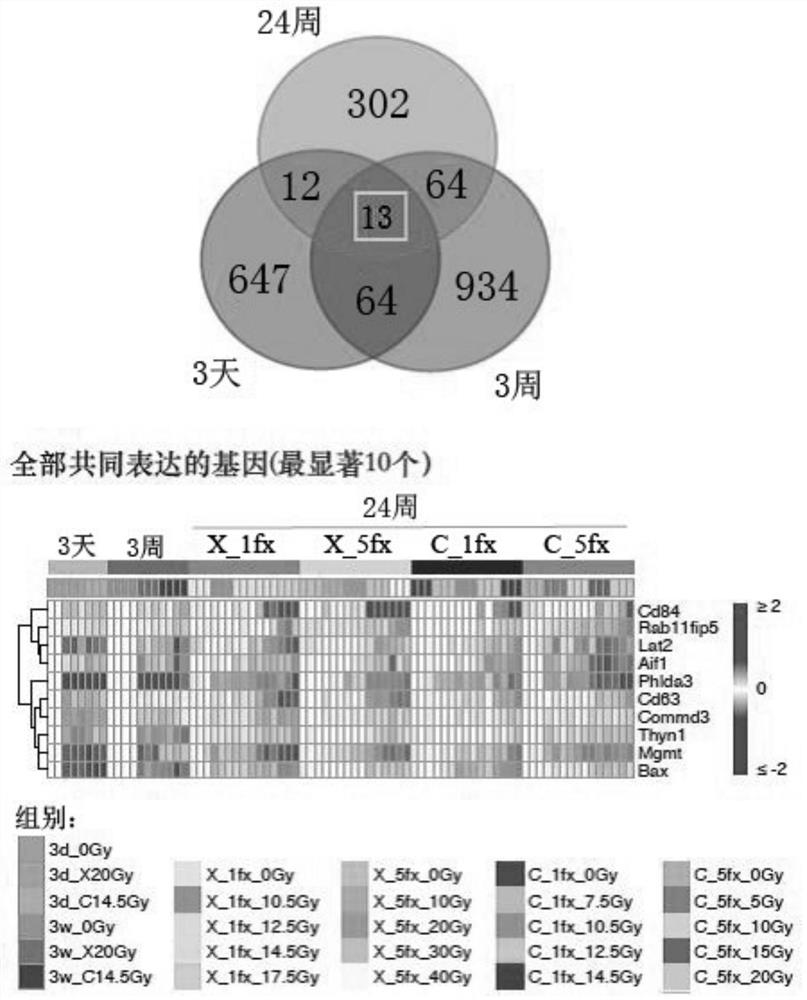Radiation-sensitive gene markers and their application in different types of radiation dose monitoring
A gene marker, radiation-sensitive technology, applied in the determination/inspection of microorganisms, biochemical equipment and methods, DNA/RNA fragments, etc., to achieve the effect of convenient risk assessment
- Summary
- Abstract
- Description
- Claims
- Application Information
AI Technical Summary
Problems solved by technology
Method used
Image
Examples
Embodiment 1
[0050] Example 1 Screening and acquisition of radiation-sensitive gene markers
[0051] 1. Irradiation and grouping of animal experiments: 8-10 weeks old C57BL6 female mice were used, SPF level rearing, the rearing conditions were, temperature (23±1) ℃, relative humidity 55%±5%, pressure difference ≤10Pa, daily Light for 12h, free access to food and water.
[0052] 2. After induction of anesthesia with isoflurane before irradiation, it was transferred to a dedicated mouse chest irradiation device and properly fixed. Whole lung field irradiation was performed using heavy ion (carbon-ions, carbon-ions) rays and X-rays. As the main representative of high LET rays, heavy ion rays are carbon particle beams (energy 280MeV) that are accelerated and drained by a cyclotron (20-30 meters in diameter), with extremely high energy and speed. X-ray is one of the representatives of low LET rays, which is irradiated after being accelerated by a medical linear accelerator (energy 6-10MV).
...
Embodiment 2
[0078] This example provides the application of the radiation-sensitive gene marker obtained in Example 1 above in the monitoring of radiation doses of different types of rays. (The application of this embodiment only lists heavy ion rays for illustration, which does not mean that the radiation-sensitive gene marker is not suitable for low-LET rays such as X-rays, and the patent scope of the present invention cannot be limited only by this embodiment)
[0079] see Figure 11 , according to the expression levels of Mgmt, Bax, Thyn1, Phlda3 four genes at different doses, the nonlinear regression model was modeled, and the irradiated heavy ion dose can be indicated according to the average value of the gene combination. According to the gene chip results, the average value of up-regulated and down-regulated gene transcription level changes (log2FC) was taken as the ordinate (that is, y represents the average value of the transcription level (log2FC) of the selected gene marker); ...
PUM
 Login to View More
Login to View More Abstract
Description
Claims
Application Information
 Login to View More
Login to View More - R&D
- Intellectual Property
- Life Sciences
- Materials
- Tech Scout
- Unparalleled Data Quality
- Higher Quality Content
- 60% Fewer Hallucinations
Browse by: Latest US Patents, China's latest patents, Technical Efficacy Thesaurus, Application Domain, Technology Topic, Popular Technical Reports.
© 2025 PatSnap. All rights reserved.Legal|Privacy policy|Modern Slavery Act Transparency Statement|Sitemap|About US| Contact US: help@patsnap.com



